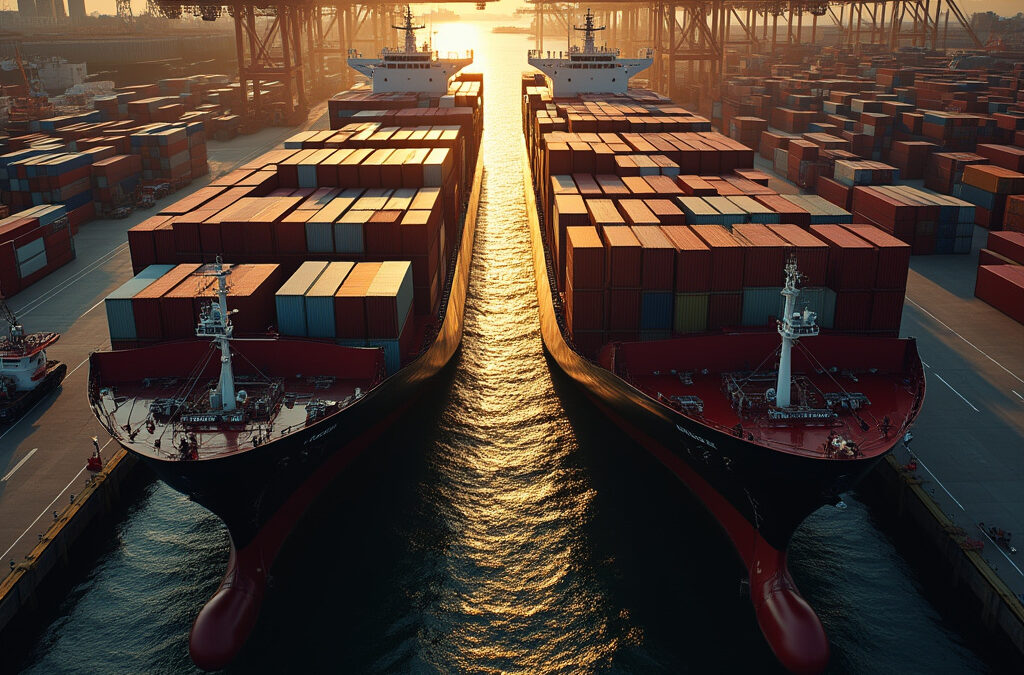The Fight Over Trump’s Proposed Port Fees on Chinese Ships
Tensions between the U.S. and China are escalating as the Trump administration proposes significant port fees on Chinese vessels and ships built in China. This move aims to revitalize America’s struggling shipbuilding and shipping sectors.
The proposed fees target Chinese-owned operators like Cosco with charges up to $1.5 million per U.S. port call. Non-Chinese operators with Chinese-built vessels face similar fees, plus up to $1 million more if over 50% of their orders are from Chinese shipyards.
Opposition is strong, with businesses warning of increased costs and supply chain disruptions. The agricultural sector fears losing global competitiveness due to higher shipping costs, while retailers predict a drop in trade volumes.
Some shipping firms threaten to halt U.S. operations, and experts caution against potential port congestion as companies minimize U.S. port visits to avoid fees.
Critics foresee a “trade apocalypse,” with billions in extra costs likely passed to consumers, harming the economy. Supporters argue the plan counters China’s unfair trade practices, boosts domestic industries, and enhances national security.
The U.S. Trade Representative held hearings, receiving mostly negative feedback. The proposal remains under review, with President Trump to decide after considering public input.
The Fight Over Trump’s Proposed Port Fees on Chinese Ships
The proposed plan includes a graduated restriction on U.S. exports, requiring an increasing percentage to be carried on U.S.-flagged and U.S.-built vessels over the next seven years. This measure aims to further support the domestic shipping industry and reduce reliance on foreign-built ships.
The agricultural sector has expressed particular concern, warning that higher shipping costs could make U.S. exports like soybeans and corn less competitive in global markets. This could lead to a decline in export volumes, negatively impacting farmers and rural economies.
Retail organizations have also voiced opposition, predicting that the fees will lead to a significant drop in both imports and exports. This could result in higher prices for consumer goods and a potential decline in trade volumes, further straining the economy.
Some shipping companies have explicitly stated that they may cease U.S. operations if the fees are implemented. This could lead to a reduction in shipping capacity, causing further supply chain disruptions and increasing costs for businesses and consumers alike.
Experts have warned that the fees could lead to port congestion as operators attempt to minimize their use of U.S. ports to avoid the charges. This could create logistical challenges, delaying the movement of goods and further disrupting global supply chains.
The U.S. Trade Representative (USTR) held public hearings to assess the impact of the proposed fees on American businesses and workers. The majority of submissions received during the public comment period were overwhelmingly negative, with businesses and industry groups expressing strong opposition to the plan.
Supporters of the plan argue that it is necessary to challenge China’s unfair trade practices in the maritime, logistics, and shipbuilding sectors. They claim that the fees will help level the playing field and support the domestic shipbuilding industry, which has struggled to compete with Chinese state-backed shipyards.
The Trump administration has also framed the proposal as a matter of national security, arguing that a strong domestic shipbuilding industry is essential for maintaining U.S. naval superiority and reducing dependence on foreign-built vessels.
The proposal is part of a broader strategy to address the competitive disadvantages faced by U.S. industries in the maritime sector. However, critics argue that the plan could have far-reaching and unintended consequences, potentially harming the very industries it aims to protect.
Conclusion
The Trump administration’s proposed port fees on Chinese ships have sparked intense debate, reflecting broader tensions in U.S.-China trade relations. Proponents argue the plan will revitalise America’s shipping and shipbuilding sectors, counter China’s unfair practices, and enhance national security. However, critics warn of significant economic fallout, including higher costs for consumers, supply chain disruptions, and potential harm to key industries like agriculture and retail.
As the proposal remains under review, the outcome hinges on balancing domestic economic interests with the risks of retaliatory measures and global trade instability. The decision will have far-reaching implications for U.S. trade policy, the shipping industry, and the broader economy.
Frequently Asked Questions
- What is the Trump administration proposing with the port fees on Chinese ships?
- The proposal imposes significant port fees on Chinese-owned vessels and ships built in China, aiming to support the U.S. shipbuilding and shipping industries.
- Who will be most affected by the proposed fees?
- Chinese-owned operators like Cosco, non-Chinese operators with Chinese-built vessels, and industries reliant on affordable shipping, such as agriculture and retail, will be impacted.
- How could the fees impact the U.S. economy?
- The fees could lead to higher shipping costs, supply chain disruptions, and increased consumer prices. Industries like agriculture and retail may face reduced competitiveness and trade volumes.
- Why is the proposal controversial?
- While supporters see it as a way to challenge China’s unfair trade practices and boost domestic industries, critics warn of economic harm, trade disruptions, and potential retaliation from China.
- What is the current status of the proposal?
- The U.S. Trade Representative has held public hearings, receiving mostly negative feedback. The proposal is under review, with President Trump expected to make a decision after considering public input.

